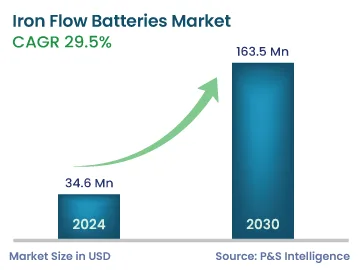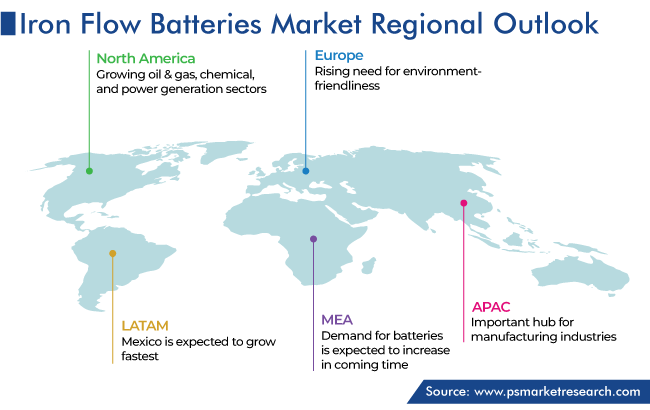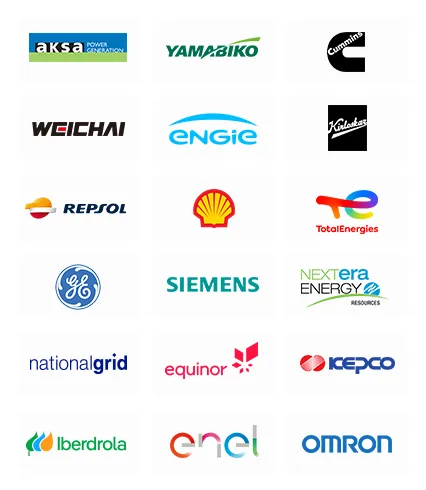Market Statistics
| Study Period | 2019 - 2030 |
| 2024 Market Size | 34.6 Million |
| 2030 Forecast | 163.5 Million |
| Growth Rate(CAGR) | 29.5% |
| Largest Region | North America |
| Fastest Growing Region | Asia-Pacific |
| Nature of the Market | Fragmented |
Report Code: 12802
Get a Comprehensive Overview of the Iron Flow Batteries Market Report Prepared by P&S Intelligence, Segmented by Type (Redox, Hybrid), Application (Utilities, Commercial and Industrial, EV charging stations, Microgrids), Material (Vanadium, Zinc Bromine), and Geographic Regions. This Report Provides Insights From 2019 to 2030.
| Study Period | 2019 - 2030 |
| 2024 Market Size | 34.6 Million |
| 2030 Forecast | 163.5 Million |
| Growth Rate(CAGR) | 29.5% |
| Largest Region | North America |
| Fastest Growing Region | Asia-Pacific |
| Nature of the Market | Fragmented |

Explore the market potential with our data-driven report
The iron flow batteries market will generate revenue of USD 34.6 million by the end of 2024, which is expected to witness a CAGR of 29.5% during 2024–2030 and reach USD 163.5 million by 2030. This will be due to the rising demand for power, integration of renewable energy sources, such as solar and wind; government support for rural electrification, the long-life cycle and safety benefits of these energy storage devices, and growing research and development activities.
Iron flow batteries have a vast role in utilities, industrial, broadcast communications, and military applications. They are also seeing penetration in applications such as roof PV systems and electric vehicle charging stations due to their technical advantages over primitive batteries, such as safety, longer lives, low self-discharge rates, high scalability, and high temperature tolerance. Iron flow batteries store energy in outer tanks in liquid electrolytes containing iron ions. To create electrochemical responses, they are siphoned into cells, unlike common batteries, which store energy in an electrode material.
Geographically, North America is going to dominate the market and display a growth rate of 50% in the coming years. This is majorly ascribed to the growing oil & gas, chemical, and power generation sectors. Furthermore, the key players are concentrated in the North American region, and they are launching new products and expanding their customer bases.
Another factor that is helping the market expand in the region is the growing need for renewable energy storage systems and the increasing emphasis on the stability of the grid. Here, iron flow batteries are finding increasing usage in a wide variety of applications, including microgrid, grid-scale, and stationary storage. Further, as a result of the rising investments in the research and development of these systems and the surging demand for long-duration energy storage solutions, the market is expected to grow rapidly in the region.

The market in APAC is expected to grow at the highest CAGR, of 30.4%, from 2024 to 2030. As a result of the inexpensive labor and raw materials, the region has been recognized as an important hub for manufacturing industries. Moreover, a lot of investments are being made by regional countries in renewable energy projects, which are helping the industry prosper.
Moreover, these batteries are expected to be used widely in microgrid applications, electric vehicles, and renewable energy installations. In regard to renewable electricity, the rising environmental awareness and strict protocols on the emissions of carbon dioxide and other GHGs in the region are propelling the market.
In major economies, such as Japan and Australia, the demand for these energy storage systems is growing in commercial, industrial, and utilities facilities. Likewise, large-scale industrial development is taking place in India and China. Thus, it is projected that the Chinese market will progress at a significant CAGR, of 30.6%.
This region has many operative flow battery installations with huge power ratings. For example, Yushan Energy has collaborated with Formosa Plastics Group to establish a storage project in Taiwan. The project uses a high-capacity flow battery system to store the excess solar energy generated during the day and discharge it when demand is high, thus improving grid reliability and stability.
To manage the demand for energy and reduce the peak load needs, these installations play a crucial role. Therefore, many utility companies have deployed flow battery projects for grid-scale applications to maintain the stability of the grid and manage intermittent renewable energy sources.
Moreover, in commercial spaces, such as offices, commercial buildings, and retail stores, these systems can help in managing energy consumption and provide backup power in case of a grid failure. Many companies have initiated the project of flow battery installations in the residential sector, these installations provide energy storage solutions for households, especially those with solar panels. Here, these ESSs store the excess energy and release it during periods of high demand.
In this region, Australia is executing several such products for industrial, utilities, commercial, and residential applications. An example is the Buronga Energy Hub in New South Wales, Australia, developed by Renew Estate. This project’s goal is to combine solar and wind energy generation with large-scale storage systems, specifically flow batteries, to contribute to the stability of the grid and allow for the integration of renewable energy.
Similarly, in February 2019, Carnegie Clean Energy commissioned a microgrid project operating a combination of wind turbines, PV arrays, and flow batteries in Western Australia. The main focus of the project is on providing reliable and sustainable power to remote communities and islands and indicating the viability of flow battery technology in off-grid settings.
Additionally, a Thai renewable energy company, Energy Absolute, is involved in grid-scale energy projects. As a part of Thailand’s energy transition efforts, it has created a large flow battery installation to integrate renewable energy sources and achieve grid stability.
This report offers deep insights into the iron flow batteries market, with size estimation for, the major drivers, restraints, trends and opportunities, and competitor analysis.
Based on Type
Based on Application
Based on Material
Geographical Analysis
The estimated value of the market for iron flow batteries in 2024 is USD 34.6 million.
By 2030, the iron flow batteries industry size will reach USD 163.5 million.
The market for iron flow batteries is propelled by the rapid urbanization, industrialization, and population growth.
The integration of renewable energy into the grid is trending in the market for iron flow batteries.
North America generates the highest iron flow batteries industry revenue.
The highest CAGR in the market for iron flow batteries will be seen in Asia-Pacific.
Want a report tailored exactly to your business need?
Request CustomizationLeading companies across industries trust us to deliver data-driven insights and innovative solutions for their most critical decisions. From data-driven strategies to actionable insights, we empower the decision-makers who shape industries and define the future. From Fortune 500 companies to innovative startups, we are proud to partner with organisations that drive progress in their industries.


Working with P&S Intelligence and their team was an absolute pleasure – their awareness of timelines and commitment to value greatly contributed to our project's success. Eagerly anticipating future collaborations.
McKinsey & Company
IndiaOur insights into the minutest levels of the markets, including the latest trends and competitive landscape, give you all the answers you need to take your business to new heights
We take a cautious approach to protecting your personal and confidential information. Trust is the strongest bond that connects us and our clients, and trust we build by complying with all international and domestic data protection and privacy laws
Customize the Report to Align with Your Business Objectives
Request the Free Sample Pages